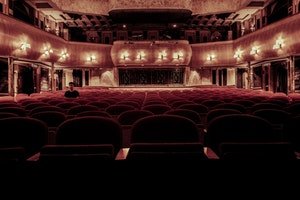You may have heard the term recitative when you hear people talk about opera, but what is recitative in opera?
Recitative is a style of monody, which is an accompanied solo song. It emphasizes and imitates the rhythms and accents of spoken language, rather than melody or musical motives.
In other words, recitative is a style of singing that is much more like ordinary talking that is being sung.
This style developed in the late 1500s in opposition to the polyphonic, or many-voiced, style of 16th-century choral music.
The earliest operas, such as Jacopo Peri’s Euridice (1600), consisted almost entirely of recitativo arioso, a lyric form of recitative intended to communicate the emotion of the text.
There are two principal varieties of recitative: recitativo secco (“dry recitative”) and recitativo accompagnato (accompanied recitative).
For now, just listen to this great definition of recitative. In this video, Bernstein demonstrates a scenario in the operatic styles of Mozart, Verdi, and Wagner.
What is a monody?
Before we talk about the two types of recitatives, let’s clarify what monody is.
Monody refers to a solo vocal style distinguished by having a single melodic line and instrumental accompaniment.
This type of music is found in different cultures. However, the term is specifically applied to the Italian song of the early 17th century, particularly the period from about 1600 to 1640.
In fact, monody developed in the 1580s and was pioneered by the Florentine Camerata. The aim was to restore ancient Greek ideas of melody and declamation.
In monody, one solo voice sings a melodic part, usually with considerable ornamentation, over a rhythmically independent bass line.
Accompanying instruments could be lute, chitarrone, theorbo, harpsichord, organ, and even on occasion guitar.
Most monodies were composed independently.
Recitativo secco or “dry recitative”
This style is easy to recognize because it is simply a vocalist with a continuo accompaniment.
Recitativo secco is sung with a free rhythm dictated by the accents of the words.
This style has minimal instrumental accompaniment. Usually, it is accompanied by a cello and a harpsichord, which makes it simple and chordal.
The melody approximates speech by using only a few pitches.
Here’s an example of recitativo secco in Italian:
Recitativo accompagnato or “accompanied recitative”
Recitativo accompagnato has a stricter rhythm and a more involved, often orchestral accompaniment.
In fact, this style employs the orchestra as an accompanying body, and the basso continuo is supplemented with the addition of other instruments.
It is less improvisational and declamatory than recitativo secco, and more song-like.
Also, this style is more emotional in character and is used at dramatically important moments.
Its vocal line is more melodic, and typically it leads into a formal aria.
Here’s an example of recitativo accompagnato in Italian:
What is an aria?
Unlike the recitative, an aria is a formal musical composition.
An aria is when one character gives voice to their feelings in a monologue and is usually part of a larger work.
It is a self-contained piece for one voice, with or without instrumental or orchestral accompaniment.
Arias are not unique to opera, as they also appear in oratorios, cantatas, and other vocal genres.
In opera, arias mostly appear during a pause in dramatic action when a character is reflecting on their emotions.
Most arias are lyrical, with a tune that can be hummed, and many arias include musical repetition.
What’s the difference between an aria and a recitative?
The main difference between arias and recitatives is that the aria is a musical piece for a single voice as part of a larger work and recitative is a musical form.
Also, in an aria, the music is more important than the words. There’s a lot of repetition and the emphasis is on the singer’s abilities, intonation, vocal agility, and voice set up.
On the other hand, a recitative is used when the composer needs to show certain emotions, such as a lament, or a heated dialogue.
It’s also useful when there’s an action that needs to happen rapidly.
Also, recitative is a musical form of speaking, so the melody is not so important.

The conventions of recitative
Recitative is a rigid musical form. The following are standard conventions of recitative:
A dialogue:
Recitative is a dialogue between a solo voice and an instrument or instruments. Usually the voice and instrument(s) alternate, or share a chord while one continues.
In this way the speech-like rhythm of the singer does not need to be coordinated and synchronized with the instrument(s).
Recitative cadences:
The dialogue ends with the instruments. Invariably the instrument(s) complete the final dominant-tonic cadence.
Also, typically the voice stops on or before the dominant chord, and then the instrument(s) execute a return to the tonic.
Recitative chord progressions:
The chord progressions in recitative avoid resolutions and rely heavily on dominant sevenths and diminished chords to postpone the resolution.
In the extreme, the instrument(s) start the dialog with a diminished chord, moving from non-resolution to non-resolution, building up to a temporary or final cadence, as described above.
Convention violations:
The transition between recitative and aria, and subtle violations on the above conventions are what make some recitatives more creative than others

Is Italian useful for opera?
If you’re (or want to be) an opera singer you may have considered learning some Italian.
Well, it wouldn’t be a bad idea. Many operas are indeed in Italian and opera originated in Italy so it would definitely make sense.
Also, some words related to opera are Italian. Just think of the words soprano, allegro, piano, and aria (=air).
Even though sometimes even native speakers don’t understand the lyrics in opera, it would be interesting to, at least, be able to read the lyrics in Italian and understand what they say.
Here are some tips for you:
If you’re an absolute beginner, we recommend learning about Italian grammar and vocabulary. You could also try our audio course “Ripeti con me!”.
If you enjoy music, we recommend listening to Italian music.
If you like watching movies, you could watch Italian movies with subtitles.
You could also attend group lessons or to 1-to-1 lessons.
If you’re thinking about it, give it a go, and see how you like it.
Good luck!



